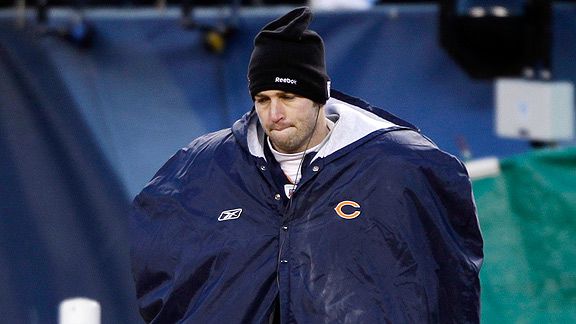Leadership Catalyst Blog
Jay Cutler of the Chicago Bears created a lot of controversy last week when a knee injury prevented him from finishing the NFC conference championship game against the Green Bay Packers. Many questioned his toughness, and believed he had “quit on his team” during their most important game of the year.
An MRI later showed the injury was indeed serious, and confirmed the decision for him not to play. It did not, however, excuse the lack of leadership and poor attitude he displayed during the remainder of the game. Instead of cheering on his teammates or supporting the backup quarterbacks, cameras repeatedly caught him sulking on the sidelines, listening to his iPod.
The lesson for CEOs is that, like Jay Cutler, we are always “on camera” in our organizations. We need to periodically check ourselves to make sure we haven’t succumbed to bad leadership habits and make sure that we aren’t displaying a poor attitude, which can be contagious for the rest of our organization.
Mike Myatt makes a compelling case that attitude reflects leadership and is a decision.
“Show me a CEO with a bad attitude and I’ll show you a poor leader. While this sounds simple enough at face value, I have consistently found that one of the most often overlooked leadership attributes is that of a positive attitude. As a CEO, how can you expect to inspire, motivate, engender confidence, and to lead with a lousy attitude? The simple answer is that you can’t…it just won’t work. CEOs with bad attitudes will not only fail to engage their workforce, but they will quickly find themselves shown the door as their attitude’s impact on performance becomes visible to the board.”
Do you need an attitude adjustment? Click here for a 5 point checklist to check yourself, and some compelling statistics about why you may want to change.
Read More >>Driving Business Results through Employee Engagement
All Blog Posts, Business, Coaching, Motivation, Strategy, Team Building / 08.05.2010
A couple of months ago, I highlighted Daniel Pink’s work on intrinsic motivation in my February 24th blog post entitled “When Traditional Motivation Doesn’t Work”. I concluded that post with the following tips.
♦♦♦♦♦♦♦♦♦♦♦♦♦♦♦♦♦♦♦♦♦♦♦♦♦♦♦♦♦♦♦♦♦♦♦ LEADERSHIP CATALYST TIPS ♦♦♦♦♦♦♦♦♦♦♦♦♦♦♦♦♦♦♦♦♦♦♦♦♦♦♦♦♦♦♦♦♦♦♦
In several turnaround situations, I have found the key to motivating and engaging employees is to:
- Make them feel valued as people and that they belong
- Help them see how what they do makes a difference, and
- Find a way for them to monitor their own contributions on an ongoing basis.
♦♦♦♦♦♦♦♦♦♦♦♦♦♦♦♦♦♦♦♦♦♦♦♦♦♦♦♦♦♦♦♦♦♦♦♦♦♦♦♦♦♦♦♦♦♦♦♦♦♦♦♦♦♦♦♦♦♦♦♦♦♦♦♦♦♦♦♦♦♦♦♦♦♦♦♦♦♦♦♦♦♦♦♦♦♦♦♦♦♦♦♦♦♦♦♦♦♦

- Employee Engagement
I recently stumbled upon a research study which validates these principles, shows how employee engagement and customer loyalty drive financial results, and illustrates how to execute these principles in a grocery store environment. The study was sponsored by the Coca-Cola Retailing Research Council and is entitled “Getting to Great: Mapping Management Practices that Drive Great Store Performance”.
The article is about 30 pages long, but well worth the time, even if you aren’t in the grocery business. Historically, the key to success in store operations has been seen as execution, and “command and control” has been a dominant leadership approach. Seeing how the above principles of employee engagement work in this situation should increase our confidence that they will work in situations involving more ambiguous and complex challenges. Below is a quick recap of their findings.
First, how do we know a great performer when we see one?
- “Great performers are those that overachieve relative to their market potential, not just those with the highest financial results.” Store results are a function not only of the leader’s performance, they are tremendously impacted by the store’s location, customer potential, competitive intensity, and store specific factors. The researchers devised a clever way of controlling for these external factors to show which store managers are executing most effectively against the strategic hand they have been dealt. (pp. 4-6)
- “Great Performers generate intense customer loyalty”.
- “Great performers produce strong employee loyalty and commitment.”
Second, what are the key management practices that great performers use to get these results?
- “Get clarity and commitment to goals. The great performers focused on the one or two most vital goals for improving their store’s performance and put their full focus behind them. By contrast, the more goals there were, the fewer were achieved with excellence.
- Get everyone to focus on the key drivers. Enlist each team member daily to take actions that have the greatest impact on achieving the main goals.
- Implement simple mechanisms to propel goal achievement. Post visible, compelling scorecards in accessible workplace locations.
- Establish a constant cadence of engagement and accountability around the key measures and goals.”
While this is a good recap, go to the report for the specifics of how to measure great performance results and the specific leadership behaviors that lead to it. It is sure to be a catalyst for ideas on how to do the same in your business!
Read More >>Algebraic Proof that Tubby Smith’s Gophers became the Best Team in the Country after working with a Leadership Catalyst!
All Blog Posts, Change, Coaching, Motivation, Team Building / 02.04.2010
On March 1st, I posted a blog about Tubby Smith bringing in a Leadership Catalyst (sports psychologist) after winning only 3 of 10 Big Ten games. On the eve of the final four, it’s time to assess whether the team really improved after that.
The gophers showed dramatic improvement, winning 7 of their last 10 conference games. They ended up beating every Big Ten team making the NCAA tournament, including impressive wins in the Big Ten Tournament against #11 MSU and #6 Purdue, which won the gophers their own invitation to the “Big Dance”. They were the only team in the nation to beat two of the Final Four teams (Butler and MSU) and beat teams that beat Duke (Wisconsin) and beat West Virginia (Purdue). According to the Algebraic Transitive Property of Inequalities (see proof below), that makes the Gophers the best team in the nation.
There you have it – mathematical (and tongue in cheek) proof that the Gophers are #1.
Congratulations Tubby, on your 17th consecutive 20 win season (21W – 14L)!
♦♦♦♦♦♦♦♦♦♦♦♦♦♦♦♦♦♦♦♦♦♦♦♦♦♦♦♦♦♦♦♦♦♦♦ LEADERSHIP CATALYST TIPS ♦♦♦♦♦♦♦♦♦♦♦♦♦♦♦♦♦♦♦♦♦♦♦♦♦♦♦♦♦♦♦♦♦♦♦
According to the Transitive Property of Inequalities,
If a < b and b < c, then a < c
Likewise:
If a > b and b > c, then a > c
If Minnesota > Wisconsin and Wisconsin > Duke, then Minnesota > Duke
If Minnesota > Purdue, and Purdue > West Virginia, then Minnesota > West Virginia
Minnesota > Butler
Minnesota > Michigan State
Therefore,
Minnesota > All Final Four Teams
♦♦♦♦♦♦♦♦♦♦♦♦♦♦♦♦♦♦♦♦♦♦♦♦♦♦♦♦♦♦♦♦♦♦♦♦♦♦♦♦♦♦♦♦♦♦♦♦♦♦♦♦♦♦♦♦♦♦♦♦♦♦♦♦♦♦♦♦♦♦♦♦♦♦♦♦♦♦♦♦♦♦♦♦♦♦♦♦♦♦♦♦♦♦♦♦♦♦
Toyota and GM: Getting Bigger at the Expense of Getting Better?
All Blog Posts, Business, Strategy / 05.03.2010
 The February 24th edition of Economist Magazine ran an article entitled “The Machine that ran too hot: The woes of Toyota, the world’s biggest car company, are a warning to rivals.” In the article, James Womack, one of the authors of “The Machine that Changed the World”, a book about Toyota’s innovations in manufacturing, dates the origin of its present woes to 2002, when it set itself the goal of raising its global market share from 11% to 15%. Mr. Womack says that the 15% target was “totally irrelevant to any customer” and was “just driven by ego”. In other words,, Toyota got itself in trouble when quality became subordinate to another goal: Selling more cars than GM.
The February 24th edition of Economist Magazine ran an article entitled “The Machine that ran too hot: The woes of Toyota, the world’s biggest car company, are a warning to rivals.” In the article, James Womack, one of the authors of “The Machine that Changed the World”, a book about Toyota’s innovations in manufacturing, dates the origin of its present woes to 2002, when it set itself the goal of raising its global market share from 11% to 15%. Mr. Womack says that the 15% target was “totally irrelevant to any customer” and was “just driven by ego”. In other words,, Toyota got itself in trouble when quality became subordinate to another goal: Selling more cars than GM.
GM apparently is not heeding the warning. WSJ reported on March 3rd “Feeling Heat From Ford, GM Reshuffles Managers“. Ford’s February monthly U.S. sales surpassed GM’s for the first time in 50 years. Hours after the sales results were released, GM announced its second executive shuffle in three months. It appears as though GM is falling into the same trap as Toyota did when it shifted it’s priority from safety and customer satisfaction to surpassing its rival in sales. As Toyota and others (Merck, Motorola, HP) have shown, doing so can lead to their downfall.
♦♦♦♦♦♦♦♦♦♦♦♦♦♦♦♦♦♦♦♦♦♦♦♦♦♦♦♦♦♦♦♦♦♦♦ LEADERSHIP CATALYST TIPS ♦♦♦♦♦♦♦♦♦♦♦♦♦♦♦♦♦♦♦♦♦♦♦♦♦♦♦♦♦♦♦♦♦♦♦
Don’t focus on getting bigger at the expense of getting better.
- Increasing scale should not be seen as the end goal, but rather as an outcome of pursuing your core purpose.
- Great leaders pursue growth in performance, distinctive difference, creativity and people, knowing sales growth will follow.
- Focusing on a noble core purpose and growth in this way will engage the hearts and minds of your people in a way that financial BHAGs never will.
♦♦♦♦♦♦♦♦♦♦♦♦♦♦♦♦♦♦♦♦♦♦♦♦♦♦♦♦♦♦♦♦♦♦♦♦♦♦♦♦♦♦♦♦♦♦♦♦♦♦♦♦♦♦♦♦♦♦♦♦♦♦♦♦♦♦♦♦♦♦♦♦♦♦♦♦♦♦♦♦♦♦♦♦♦♦♦♦♦♦♦♦♦♦♦♦♦♦
Read More >>Tubby Smith, U of MN BB Coach, Hires Catalyst
All Blog Posts, Change, Coaching, Motivation, Team Building / 01.03.2010
 Tubby Smith, the University of Minnesota men’s basketball coach has 16 consecutive 20 win seasons for a reason. He is a great coach, and he recognizes when it is time to find a catalyst to help unlock the potential of his team. This year’s 17-11 team is likely not performing up to its true potential because 7 of their 11 losses were decided by less than 5 points. They have had major leads over ranked teams such as Michigan State and Purdue, only to see them erased in the final seconds. In fact, they have only won 4 of 11 close games this season.
Tubby Smith, the University of Minnesota men’s basketball coach has 16 consecutive 20 win seasons for a reason. He is a great coach, and he recognizes when it is time to find a catalyst to help unlock the potential of his team. This year’s 17-11 team is likely not performing up to its true potential because 7 of their 11 losses were decided by less than 5 points. They have had major leads over ranked teams such as Michigan State and Purdue, only to see them erased in the final seconds. In fact, they have only won 4 of 11 close games this season.
In an effort to find a remedy to the mental breakdowns his team was having with the game on the line, coach Smith brought in a sports psychologist according to Myron Medcalf of the Minneapolis Star Tribune. Players report that he taught them to use “positive affirmations” and envision good outcomes in tough stretches. They further claim that the approach helped them survive a late game surge by the fighting Illini in a 62-60 victory on Saturday.
For many, “positive affirmation” conjures up images of SNL’s Stuart Smally (aka Senator Al Franken) looking into the mirror and saying “…and darn it, people like me”. However, there is a lot more science to them than that, and no doubt you have recently observed Olympians mentally rehearsing flawless performances on the slopes and on the ice before they compete. This same technique works in coaching executives before tough board meetings or critical or contentious negotiations.
♦♦♦♦♦♦♦♦♦♦♦♦♦♦♦♦♦♦♦♦♦♦♦♦♦♦♦♦♦♦♦♦♦♦♦ LEADERSHIP CATALYST TIPS ♦♦♦♦♦♦♦♦♦♦♦♦♦♦♦♦♦♦♦♦♦♦♦♦♦♦♦♦♦♦♦♦♦♦♦
To increase the odds of success for executives in these critical situations, help them:
- Imagine themselves in the situation
- Anticipate the tough questions and challenges they likely will encounter
- Visualize themselves calmly and effectively responding to those challenges
- Practice responding to those challenges with someone playing an adversarial role.
♦♦♦♦♦♦♦♦♦♦♦♦♦♦♦♦♦♦♦♦♦♦♦♦♦♦♦♦♦♦♦♦♦♦♦♦♦♦♦♦♦♦♦♦♦♦♦♦♦♦♦♦♦♦♦♦♦♦♦♦♦♦♦♦♦♦♦♦♦♦♦♦♦♦♦♦♦♦♦♦♦♦♦♦♦♦♦♦♦♦♦♦♦♦♦♦♦♦
The bottom line is that effective coaches and business leaders recognize when their teams are not performing up to potential, and do not hesitate to find a catalyst to help them get back on track.
Read More >>Welcome To My Blog!
All Blog Posts / 24.02.2010
I am a Leadership Catalyst, and will be posting observations and tips about how to unleash the potential of leaders and organizations. More specifically, I will be focusing on how to help leaders build strong teams and engage the hearts and minds of their people. Observations will be taken from my 25+ years of consulting and leadership experience as well as from other publications and posts in the blogosphere. I welcome your comments and appreciate your stopping by!
Brian L. Davis, Ph.D.
Leadership Catalyst
Read More >>




